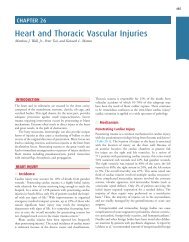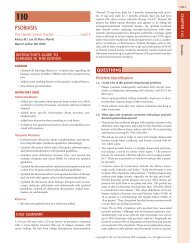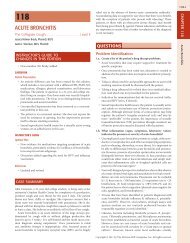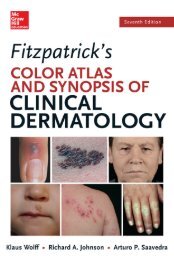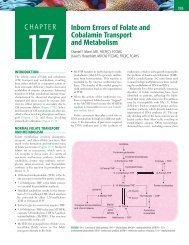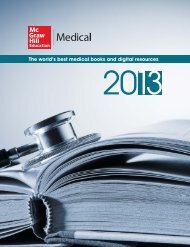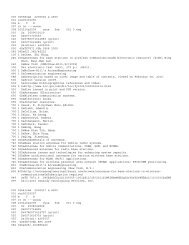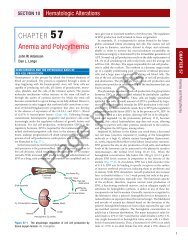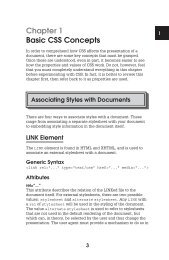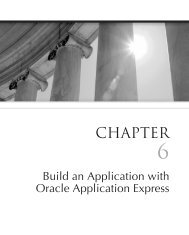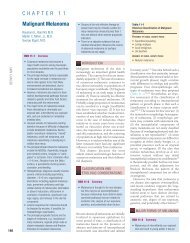Seizures and Epilepsy
Seizures and Epilepsy
Seizures and Epilepsy
You also want an ePaper? Increase the reach of your titles
YUMPU automatically turns print PDFs into web optimized ePapers that Google loves.
38 ■ Section 2: Common Pediatric Neurologic Problems<br />
Syndromes<br />
Benign familial neonatal seizures<br />
Benign familial neonatal seizures occur as a genetic<br />
disorder with an autosomal dominant inheritance pattern<br />
associated with chromosome 20q. The seizures<br />
typically start on day of life 2 or 3. The neonate may<br />
have as many as 10 to 20 seizures per day. The syndrome<br />
is usually self-limited <strong>and</strong> benign, but approximately<br />
10% of cases progress to an antiepileptic<br />
drug-requiring seizure disorder. Neurological development<br />
is normal. 58–61<br />
Fifth-day fits<br />
Fifth-day fits usually begin on day of life 4 to 6. The<br />
seizures are typically multifocal clonic seizures <strong>and</strong> are<br />
frequently associated with apnea. The seizures usually<br />
last for less than 24 hours. Fifth-day fits progress to status<br />
epilepticus in 80% of cases. 58–61<br />
Benign neonatal sleep myoclonus<br />
Benign neonatal sleep myoclonus begins during the first<br />
week of life. The seizures are usually bilateral myoclonic<br />
jerks that last for several minutes <strong>and</strong> occur only during<br />
NREM sleep. The EEG is normal or slow. The seizures<br />
worsen with the administration of benzodiazepines. The<br />
seizures usually resolve within 2 months <strong>and</strong> neurological<br />
outcome is normal. 58–61<br />
Benign myoclonus of early infancy<br />
Benign myoclonus of early infancy has an onset at age 3<br />
to 9 months but it can be much earlier. The seizures<br />
resemble infantile spasms but the EEG is normal. The<br />
seizures usually occur while the patient is awake. The<br />
seizures disorder may continue for 1 to 2 years but neurological<br />
outcome is normal. 58–61<br />
Treatment<br />
The clinician should first search for underlying etiologies<br />
producing the seizures <strong>and</strong> treat (hypoglycemia,<br />
hypocalcemia, sepsis). If the clinician cannot find a<br />
readily identifiable <strong>and</strong> treatable etiology, the frontline<br />
agent of choice for treating seizures is phenobarbital<br />
(see Table 3-14 for dosing suggestions). 62 Phenobarbital<br />
as a single agent will stop seizure activity in 42% of<br />
patients. When the seizure does not respond to a single<br />
agent, phenytoin is added with an increase in efficacy to<br />
65%. Currently, fosphenytoin, the salt ester of phenytoin,<br />
is preferred in the neonate because it is an aqueous<br />
solution that is soluble in glucose-containing solutions,<br />
can be administered more quickly than phenytoin, <strong>and</strong><br />
will not cause “purple glove syndrome.” 62 Purple glove<br />
syndrome is necrosis or injury of the soft tissue that can<br />
occur with intravenous infusion of the highly alkaline<br />
phenytoin. The drug of choice for neonates in status is<br />
lorazepam. This agent has several properties that make<br />
it ideal—a long half-life <strong>and</strong> a small volume of distribution,<br />
which prolongs its retention at high levels in the<br />
brain.<br />
REFERENCES<br />
Table 3-14.<br />
Neonatal AED Dosing Suggestions<br />
Phenobarbital—20 mg/kg load over 10 to 15 min.<br />
If necessary add more phenobarbital in 5-mg/kg boluses<br />
Fosphenytoin—20 mg/kg at 1 mg/kg/min<br />
Ativan—0.1 mg/kg<br />
From Rennie J, Boylan G. Treatment of neonatal seizures. Arch Dis Child Fetal<br />
Neonatal 2007;92:F148–F150.<br />
1. Hauser WA, Beghi E. First seizure definitions <strong>and</strong> worldwide<br />
incidence <strong>and</strong> mortality. Epilepsia. 2008; 49(suppl 1):<br />
8-12.<br />
2. Teasell R, Bayona N, Lippert C, Villamere J, Hellings C.<br />
Post-traumatic seizure disorder following acquired brain<br />
injury. Brain Inj. 2007;21:201-214.<br />
3. Statler KD. Pediatric posttraumatic seizures: epidemiology,<br />
putative mechanisms of epileptogenesis <strong>and</strong> promising<br />
investigational progress. Dev Neurosci. 2006;28:<br />
354-363.<br />
4. Agrawal A, Timothy J, P<strong>and</strong>it L, Manju M. Post-traumatic<br />
epilepsy: an overview. Clin Neurol Neurosurg. 2006;<br />
108:433-439.<br />
5. Weber YG, Lerche H. Genetic mechanisms in idiopathic<br />
epilepsies. Dev Med Child Neurol. 2008;50:648-654.<br />
6. Leventer RJ, Guerrini R, Dobyns WB. Malformations of<br />
cortical development <strong>and</strong> epilepsy. Dialogues Clin Neurosci.<br />
2008;10:47-62.<br />
7. Steinlein OK. Genetics <strong>and</strong> epilepsy. Dialogues Clin Neurosci.<br />
2008;10:29-38.<br />
8. Griffith JF, Ch’ien LT. Herpes simplex virus encephalitis.<br />
Diagnostic <strong>and</strong> treatment considerations. Med Clin North<br />
Am. 1983;67:991-1008.<br />
9. Geyer J, Keating J, Potts D, Carney P, eds. Neurology for the<br />
Boards. 3rd ed. Philadelphia: Lippincott Williams &<br />
Wilkins;2006.<br />
10. Riviello JJ. Classification of seizures <strong>and</strong> epilepsy. Curr<br />
Neurol Neurosci Rep. 2003;3:325-331.<br />
11. Durón RM, Medina MT, Martínez-Juárez IE, et al.<br />
<strong>Seizures</strong> of idiopathic generalized epilepsies. Epilepsia.<br />
2005;46:34-47.<br />
12. Gardiner M. Genetics of idiopathic generalized epilepsies.<br />
Epilepsia. 2005;46(suppl 9):15-20.<br />
13. Jallon P, Latour P. Epidemiology of idiopathic generalized<br />
epilepsies. Epilepsia. 2005;46(suppl 9):10-14.



